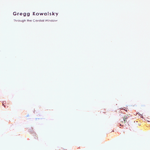Gregg Kowalsky, "Through the Cardial Window"
 Electro-acoustic ventures will either sound warm, welcoming, and exciting from the start or they will be colder and less appealing. Cold, approximated experiments often yield the latter for me, drawing more yawns than squeals of excitement. Gregg Kowalsky's effort is a balance between auditory masturbation and consistent hammering; if the music doesn't yield to his desires, Kowalsky just tries to pound it into happy submission.
Electro-acoustic ventures will either sound warm, welcoming, and exciting from the start or they will be colder and less appealing. Cold, approximated experiments often yield the latter for me, drawing more yawns than squeals of excitement. Gregg Kowalsky's effort is a balance between auditory masturbation and consistent hammering; if the music doesn't yield to his desires, Kowalsky just tries to pound it into happy submission.
Kranky
To the extent that most strange recording techniques have become familiarized and assimilated into common nomenclature, there isn't much new that Kowalsky can offer. Flatulence and sexual intercourse have both been utilized as sources for musical material, mathematics and deliberate chance have both had their say in the arrangement and construction of many musical pieces, and musicians have traveled to many remote locations in order to inject their work with the spirit of whatever locale they happened to like that year; truly innovative recording techniques are either difficult to come by or too difficult to understand for the every day listener. Thus Kowalsky's interesting recording techniques might fail to draw listeners in the same way that Nurse with Wound's or Coil's rather well-known and strange procedures have. All we're left with is Kowalsky's arid compositions, stretching out over 45 minutes and seven tracks. As far as drone goes, there's almost no distinction between Kowalsky's work and many other great drone composers; Kowalsky's work actually pretends to move less than a piece from someone like Colin Potter. Kowalsky simply introduces sounds at the beginning of each piece and then adds to them, failing to provide any sense of progression in the original tones. Thus, as a piece moves forward by way of layering, it also retains some sense of rest or inactivity. When the sounds are interesting and intriguing in and of themselves (like they are on "Coral Gables"), the effect is soothing and joyful. At times I never wanted that particular track to stop. When the music is slow going and sounds reminiscent of drab laboratories, then the desire to press the skip button on the CD player is all-consuming.
So, as the album progresses, there is a frustrating oscillation between captivation and sheer boredom. Listening to a composer like Keith Fullerton Whitman or Carl Stone typically involves constant hypnosis; their music is simultaneously academic and entertaining. On the other hand, listening to a poor album from any number of noise makers instigates an instant case of dry mouth without the desired high. Kowalsky falls flatly in the middle of these two extremes. Four of the seven tracks leave an impression on me, bewilderingly denying their length because of the beauty with which they resonate. The remaining tracks nearly ruin the album, especially because two of them are present on the first half of Through the Cardial Window.
This is, then, an imperfect record with qualities to be enjoyed and appreciated. Expect nothing more than drone-like material; patterns, ideas, and tones stretched out over eternity, with only the slightest hint of action. The entire record has an airy quality that places it in the firmament, with few terrestrial characteristics to ruin that notion. This album floats more than it grinds and it behaves predictably, with few surprises to be found anywhere. Perhaps this is simply what a normal, average drone record sounds like or perhaps this is the effort of a composer who wasn't quite sure how to move from one idea to the next. Whatever the case may be, it's difficult to fully endorse this record as anything more than decent. A little extra movement and a more definite attitude towards progression would've made this record far more exciting. Right now, I have it on in the background and am completely happy with ignoring the majority of it while watching the rain. This is ambient music in the truest sense, made for background play with nothing shocking or impressive enough to interrupt a calm space.
samples:



